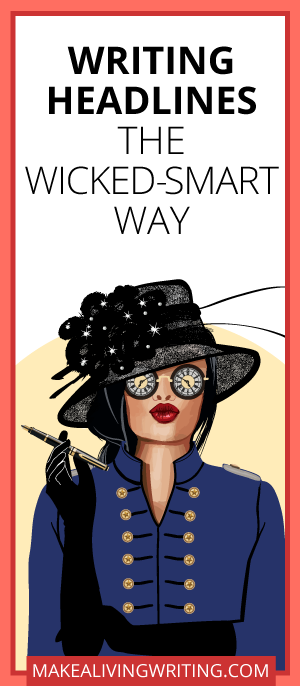
It’s part art. It’s part science. It requires great writing skills. And if you have the ability to look inside the human psyche to figure out what keeps your readers up at night, even better.
Writing great headlines doesn’t happen by accident.
In fact, the smartest blogger in the world typically spends 2 to 3 hours writing a single headline, crafting up to 50 variations to get it right.
Ever struggle with writing headlines and just slap something together? Don’t do that, OK.
Learning to write better headlines is a valuable skill that can help you move up and earn more…a lot more.
For example: Smart Blogger CEO Jon Morrow can command $5,000 per blog post, because he knows how to write irresistible headlines that generate millions of views.
Want to learn how to write better headlines? Check out these 15 tips from the most wicked-smart blogger in the world:
Jon Morrow: The most wicked-smart blogger in the world

Smart Blogger CEO Jon Morrow
Meet Jon Morrow, the most wicked-smart blogger in the world.
He’s the founder and CEO of SmartBlogger.
He’s written thousands of posts for some of the most popular blogs on the Internet, including ProBlogger.com, NeilPatel.com, and many others. He earns an average of $100K a month as a blogger, copywriter, and freelance writing coach.
And he’s helped scores of writers master the skills of writing headlines, crafting blog posts, driving traffic, and making money. In a Freelance Writers Den podcast with Carol Tice, Jon discussed his strategies and ideas for writing headlines.
1. What’s the problem with most blogging headlines?
Jon: A lot of headlines don’t have a benefit in it. The easiest way to understand this is instead of having a blog or website, imagine you’re standing in the checkout lane at the grocery store, and you’re looking at all those magazine headlines.
You decide to buy one of those magazines, purely based on one of those headlines on the cover. If there’s a good headline, it goes into the cart. If it doesn’t, it stays on the shelf. That magazine lives and dies based on the quality of its headlines.
And online, it’s the same thing.
2. What type of headline stands out the most?
Jon: It either has something to arouse your curiosity, or it has a benefit. People have actually studied this scientifically, and they found out that benefit headlines get more attention than any other type of headline.
3. Can you give an example of a great benefit headline?
Jon: The magazine that’s generally agreed upon among copywriters that writes the most compelling headlines is Cosmopolitan. Here’s an example: 7 Crazy Sex Positions to Drive Your Man Wild in Bed. That’s one of the types of headlines that they would run.
For a blogger, it might be how to get more traffic. If you’re an entrepreneur, it might be how to get more sales. If you’re writing for parents, it might be how to get your kids to behave.
Whatever you’re writing about, you need to figure out what the audience wants to achieve and wrap that into a benefit headline promising you’ll help them do that.
4. What’s another element that gets people to pay attention to headlines?
Jon: There are some words that stand out more than others, words that have more of an emotional punch. If you look for words that pack an emotional wallop, that’s what’s going to get people to pay attention.
5. What are some constructs that work well for writing headlines?
Jon: There are two constructs that are by far the most successful, and where I suggest everyone start.
- How-to headlines. For example: How to Get Your Kids to Pay Attention to You at the Dinner Table.
- List headlines: For example: 6 Ways to Get Your Kids to Pay Attention to You at the Dinner Table.
Those two types of headlines, if you study headlines mathematically and scientifically on the Internet, represent a huge percentage of the most popular articles online.
6. What do you recommend if you get stuck writing a great headline?
Jon: Whenever I get stuck, I write a how-to headline. Usually several of them. Just to help me get down what I’m trying to say. That’s where I would start.
One of the other things you should be doing, is to start paying attention to the response that different articles are getting online. Look at the response. Look at the comments. And look at the headlines to start noticing patterns.
You could also do this with junk mail. Don’t throw it away. Look at the headlines and figure out which ones would keep you from throwing it away, and start seeing the patterns. You can learn a lot from doing this.
7. What should you look at before you write a blog post?
Jon: Data. I write for some of the most popular blogs in the world. And what I love about is that there is so much data available. Most blogs have a list of popular posts that you can look at, and kind of see what topics are consistently popular, and what kind of headlines they’re using.
You can also follow a blog for a month or two. Read it. Watch the comment counts, the Tweet counts, and the Facebook likes. And see what’s getting the most traffic and engagement.
8. What drives up the amount of money you can earn from a blog post?
Jon: One of the things I learned early on in my writing career, is the people who get paid big money, they’re not being paid for their words. They’re being paid for their traffic.
The reason I earn over $5,000 for every article I write, isn’t because I’m a better writing than everybody else. It’s because my posts and my articles bring in more traffic than anybody else. No one is going to pay me $5,000 for a 1,000-word article. But they will pay me $5,000 for 50,000 new readers.
9. What happens when you pitch an editor with a bad headline?
Jon: About 95 percent of the submissions I’ve received as an editor have had horrible headlines. And a lot of times what will happen is, we decide whether or not we’re even going to read the article based on the headline. If it has a bad headline, then we don’t even read it. You can get rejected without an editor ever reading your work because of a bad headline.
10. How much time do you spend writing a headline?
Jon: I generally spend 2 to 3 hours writing a headline. I’ll write out 20, 30, 50 different headlines. And I’ll sit there and think about it for hours about exactly what’s going to make this irresistible. I want the posts I write to go viral, and having a great headline is one of the requirements to make that happen.
The more time you can put into writing headlines, the better. A lot of people write headlines as an afterthought. Instead of spending two hours writing a headline, they’ll spend 30 seconds. And it’s why a lot of writers have trouble making money. Almost all the professional writers I know spend time writing their headline first.
11. How does SEO factor into writing headlines?
Jon: It’s important to understand how SEO works. A lot of people misunderstand this, and it leads to problems with this question. To get to the first page of Google, you cannot optimize your way to get there.
- It doesn’t matter how many keywords you have.
- It doesn’t matter if the keyword is in your headline.
- It doesn’t matter if the keyword is in your post log.
- It doesn’t matter what your keyword density is.
They keywords in your post don’t tell Google how high to rank you. It has almost no effect on that. You might have a perfectly-written article with the right mix of keywords. But that post might show up on page 54 of Google search results, and that’s one reason nobody knows who you are.
However, if your site has a lot of links, and recognized as a trusted site by Google, it’s possible that everything you write goes to the first page of Google.
12. How can you improve search rankings for your site as a new blogger?
Jon: If you’re a new blogger, you need to focus on links first. No matter what you do, you’re not going to be able to rank for competitive terms. You might be able to get enough traffic from local key phrases like “Charlotte North Carolina freelance writer,” but if you’re trying to rank for national or international keywords, it’s going to be a lot harder.
For example, one of my friends wanted to rank for “personal development,” and the last time I checked it got like 350,000 searches a month. If you want to rank for something like that, then the first year of your blog, you’re going to have a hard time getting there. What you’d need to do is write really captivating headlines, and not even worry about keywords for the first year until your blog has the authority to start ranking.
13. Should you ALWAYS include a key phrase in your headline?
Jon: If you can get it in there without sabotaging the headline, great. Go for it. But if you find forcing a keyword makes your headlines weird or funky, or you throw away an interesting headline in favor of one that’s more boring that has the keywords in it, that’s wrong. You really don’t want to do that. If you can get the keyword in without hurting your headline, go for it.
14. What’s another way to come up with creative headlines?
Jon: One thing that I used to do when I was first getting started, was go to Barnes and Noble, and go through dozens of magazines. I’d look at all the covers, and write down all of the headlines I liked. And to this day, I have a file with over 500 different headlines in it. Whenever I need a headline, and I’m stuck. I’ll read through that. And that will give me an idea.
I used to subscribe to Comospolitan, I’m not a woman, and I don’t read it. But I used to get it, tear off the cover, and throw the magazine away. I actually have a stack of Cosmopolitan magazine covers. You need to start collecting those.
The highest paid copywriters in the world like Dan Kennedy, who’s starting fee is like $100,000, actually bought a condo next to his home to hold all of his old letters, magazine covers, books, and huge collection of things he swipes from. Whenever he works, he walks over to that other condo with 50 years of direct mail, postcards, and magazines. He’ll go over and sift through those things just to get examples of what works when he’s writing a new piece.
15. How can you think more like your readers to drive traffic?
Jon: The main thing, your blog post should be talking about something your readers want to know. The more desperate they are to know, the better. You need to know what keeps your readers awake at night. If the issue isn’t powerful enough to keep someone awake until 4 a.m. in the morning unable to sleep, then it’s not important enough be writing about it.
16. Write the headline first, or at the end?
Jon: I usually write the headline first. By the end of the post, I usually go back and tweak it a little bit. A good headline will make you a lot more efficient, because it will give you direction. They’re just so important, you need to prioritize writing headline.
There’s a study from a couple years ago, where they found that an article’s headline is responsible for 80 percent of the traffic it gets. What that means is, if you’ve got a few hours to write an article, spend an hour and half on the headline, and 30 minutes writing the article.
Learn to write better headlines
If you want to move up and earn more, learn to write better headlines. Study high-traffic blogs and popular magazines. Pay attention to headline constructs, style, and format. Look at what types of blog posts get the most traffic. And you’ll get better at writing headlines with every post you publish.
Need help writing better headlines? Let’s discuss in the comments.
Evan Jensen is the blog editor for Make a Living Writing. When he’s not on a writing deadline or catching up on emails, he’s training to run another 100-mile ultra-marathon.










